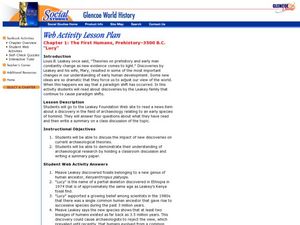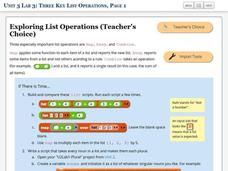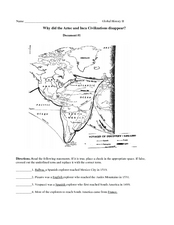Curated OER
Discoverers and Explorers Crossword
In this world history learning exercise, students answer 10 clues to fill a crossword puzzle with words associated with world explorers and discoverers. They work across and down with names of explorers and the places they explored.
Curated OER
The First Humans: Prehistory-3500 B.C. "Lucy"
Students explore prehistoric times by completing web activities in class. In this human ancestry lesson, students identify the archaeological discovery of the "Lucy" skeleton and what it meant for science. Students investigate the Leakey...
Curated OER
Discovery Channels
Students read a New York Times article in order to explore issues about the celebration of Columbus Day. They, working in groups, research the legacy of exploration and colonization. They use the research to create a first person narrative.
Curated OER
The Search for the Lost City of El Dorado
Ninth graders research the reasons to why people want to find the city of El Dorado. In this Spanish exploration lesson, 9th graders read an article and answer guided reading questions. Students present their findings to the...
Curated OER
Settling Nroth America: Improvisation and Playwriting
Students map the classroom by marking the movement of the first Americans' migration from Alaska down into North America. To improve their skills in map-reading and sense of direction, students identify physical features of the map and...
Curated OER
The Great Exchange
Sixth graders examine the connection that the present has to the past and how different cultures impact each other with lasting results. They discuss European exploration in North America and West Africa by describing cultural...
Curated OER
Leaves
Students explore, observe, and collect leaves from outside. They make journal entries, discuss the differences and common features of leaves and what function leaves serve. They will discuss the plant and tree leaves. Students draw...
Curated OER
Redwood Trees: How Does Water Get to the Top of the Tree
Students discuss photosynthesis. They explore and discuss surface tension, hydrogen bonding and capillary action with hands on experiments. They make journal entries and draw pictures of the different stages of the experiments.
American Museum of Natural History
Race to the South Pole
Antarctica was the last continent humans explored. Explore how two teams raced to be the first using an interactive online lesson. Users learn about the climate challenges and how the teams sought to overcome them. The resource is...
Beauty and Joy of Computing
Three Key List Operations
Develop an understanding of the Map, Keep, and Combine operations. The lab leads the class through the exploration of three list operations. Each task contains a self-check to measure scholars' understanding of the operation in the...
American Museum of Natural History
Journey to the Stars
Fifteen detailed pictures and informative captions delve deep into the exploration of stars—their life cycle and importance in the universe.
Curated OER
History's Thermometers
Ancient coral beds give scientists clues to past ocean temperatures in much the same way that tree rings indicate historical weather conditions. High school scientists examine coral oxygen isotope ratios and plot the data as a function...
Curated OER
The Feudal System: Castles at War
Learners study the feudal system of the Middle Ages. In this Middle Ages activity, students watch "The Feudal System at War". Learners listen to an instructor-delivered lecture regarding the roles of monarchs, nobles, knights, and...
Curated OER
How Did Humans Evolve?
Students are introduced to four important fossil finds: the First Family, the Hadar Skull, Lucy, and the Laetoli Footprints. They explore how scientists interpret fossils to try to better comprehend how humans evolved. This activity...
Curated OER
The Discovery of the Americas: A Play About Early Explorers
Students perform a play about the early explorers to America.
Curated OER
Exploring Special Lines
Students compare and order numbers. In this geometry lesson, students write equations for inequalities. They differentiate and apply concepts of triangular properties to solve problems.
Curated OER
Voyage to the New World
Students examine the exploration of the New World. They write a descriptive account of the first encounter between Europeans and Native Americans, analyze and label maps, plot Columbus's journey on a map, and write a chapter summary.
Curated OER
Journal of a Virtual Expedition
Students journey with Lewis and Clark. In this literature lesson, students read The Journal of Augustus Pellitier-The Lewis and Clark Expedition 1804. Students keep a journal in the persona of a member of the expedition crew.
Curated OER
Where Did Foods Originate? (Foods of the New World and Old World)
What do papayas, peanuts, pineapples, and potatoes have in common? Why, they are foods explorers brought back to the Old World. Young researchers use the Internet to investigate how New World explorers helped change the Old World's diet....
Curated OER
The European Conquest of the Americas
Witness the birth of the Americas in this presentation, which details the European Explorers who contributed to adding vital details on our modern-day maps. Viewers' worlds will literally expand after seeing the results of Cortes and the...
Curated OER
American Women Who Shaped the Civil Rights Movement Explored Through the Literature of Eloise Greenfield
Examine the women who contributed to the Civil Rights movement. In groups, children read excerpts of writings from Eloise Greenfield and research the women she mentions using the internet. To end the activity, they create a timeline of...
Curated OER
Why did the Aztec and Inca civilizations disappear?
Middle schoolers can analyze primary source documents to answer the question, "Why did the Aztec and Inca civilizations disappear?" They will read the provided excerpts then answer 11 different questions to uncover the ultimate answer.
National Endowment for the Humanities
Not 'Indians,' Many Tribes: Native American Diversity
Students explore what they thought they knew about "Indians." They examine the Hopi, Abeneki and Kwatiutl tribes in a game-like activity using archival documents.
Channel Islands Film
Island Rotation: Lesson Plan 3
How far have California's Channel islands moved? What was the rate of this movement? Class members first examine data that shows the age of the Hawaiian island chain and the average speed of the Pacific Plate. They then watch West...

























